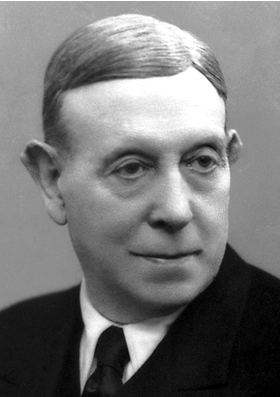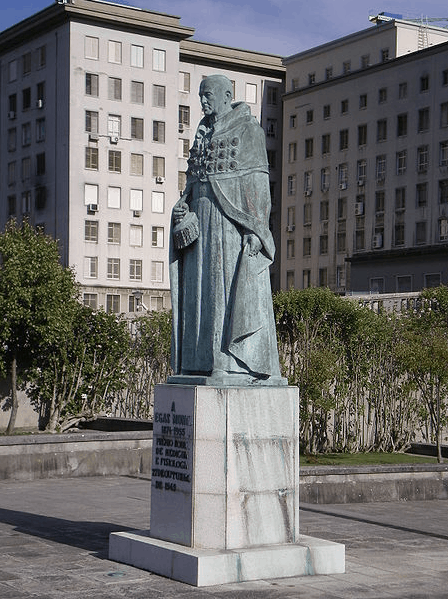Godfather of the Lobotomy: Egas Moniz
In 2010 we saw no big celebrations marking the 75th anniversary of the development of psychiatric surgery — not even in Portugal, where the first brain operations to treat psychiatric disorders, eventually leading to lobotomies, were performed. But the passing of the anniversary offers a good reason to wonder: How would someone come up with the idea to cut into the brain to alleviate mental illnesses, and what kind of physician would rely upon the medical technology and knowledge of the human brain of the 1930s to act on such a notion?

While researching my book The Lobotomist: A Maverick Medical Genius and His Tragic Quest to Rid the World of Mental Illness (published by Wiley), I grew intrigued by the wild ups and downs in the career of Egas Moniz, the neurologist who led the first modern surgical incursions into the brain to treat the soul. Moniz was no quack or crank, and his intellectual gifts were undeniable. Born in 1874 in Avanca, Portugal, he indulged his first passion, leftist politics, as a university student. After completing medical school, he studied and wrote about the physiology of human sexuality — long preceding Masters and Johnson — and taught medicine in Lisbon. In 1910, however, the fall of the Portuguese monarchy reignited his political interests, and Moniz won election to the national parliament. He quickly rose to the government’s upper ranks, serving as minister to Spain, minister of foreign affairs, and Portugal’s representative at the signing of the Treaty of Versailles, which ended World War I. Suddenly and unexpectedly, Moniz had become the most politically powerful physician in the world.
Moniz leaves politics
Then, just as abruptly, his political influence ended in 1920 with the ascent of a rightist regime and a military coup that followed. Moniz returned to medicine, where he soon became just as prominent as he had been in politics. He developed cerebral angiography, the world’s first procedure for imaging the brain, in which he injected sodium iodide into the carotid artery to allow the brain’s circulatory system to appear under x-ray photography. Never before could physicians see brain tumors, cysts, aneurysms, and other problems without opening the skull. The invention earned Moniz a Nobel Prize nomination in 1928 and in succeeding years.
Moniz was on a roll. Although cerebral angiography had required years of experimentation and soon influenced medical specialties beyond neurology, its boldness faded in comparison with Moniz’s next major investigation, the development of psychiatric surgery, which began in 1935.
By 1935, Moniz was 61 years old, prematurely wrinkled, coldly withdrawn, and painfully afflicted with gout. That year he attended a medical conference in London, where he sat in on a presentation by the American experimental psychologist Carlyle Jacobsen. It detailed the removal of the frontal lobes of two chimpanzees in a laboratory at Yale. One of the chimps became less prone to frustration and anxiety when confronted with difficult tasks. According to others in attendance, Moniz rose and asked whether surgery on the frontal lobes of people might diminish the anxiety that often accompanies psychiatric disorders. The question struck many people as shocking and rash, because nobody had previously voiced the notion of intentionally damaging the frontal lobes of humans for any therapeutic purpose.
Moniz received no support for his idea at the conference, but he returned to Portugal and quickly began a series of brain operations on mentally ill patients in partnership with the neurosurgeon Almeida Lima. Years later, he wrote that since the early 1930s he had been ruminating over ways to improve the symptoms of psychiatric patients by disrupting neural pathways in the brain and that he had no memory of the question he had supposedly raised at the London conference.
A new kind of surgery
Regardless of the origins of this new surgery, which he called leucotomy (he also coined the term “psychosurgery”), Moniz hypothesized that it would help patients because their illnesses were caused by rigid neurological circuitry in the brain, which led to the fixed delusions and obsessions of such diseases as schizophrenia, obsessive-compulsive disorder, and depression. Disrupting the circuitry might diminish the symptoms, he speculated. During a leucotomy, Moniz did not remove portions of the frontal lobes, but he opened the skull to damage or cut the neural pathways that connected the frontal lobes with other regions of the brain.
Of his initial twenty leucotomy patients operated on during 1935, Moniz determined that 70 percent were improved or cured when he followed up on them a few weeks later. He rushed to publish these results in several European medical journals. Immediately Moniz faced a firestorm of criticism, including skepticism over his hypothesis for the causes of psychiatric disorders, but he remained undeterred. Walter Freeman, an American neurologist who Moniz had met in London, read these articles and worked with the neurosurgeon James Watts to launch a series of similar surgeries in the US during 1936. Eventually Freeman would have a hand in 3,400 of such operations through 1967, which he called lobotomy. Between 40,000 to 50,000 lobotomies were performed in the US over many decades, and as many as 100,000 worldwide.
Moniz was on a roll.
Moniz finally won the Nobel Prize in medicine and physiology in 1949 for his development of psychosurgery, an award that helped move lobotomy into the medical mainstream. (He energetically lobbied Walter Freeman, with whom he carried on a long correspondence, to nominate him for the prize.) But tragedy marred his life as well. In 1939 a patient suffering from hormonal disorders (and not a leucotomy recipient) appeared in his office with a gun. “I knew at the fifth shot that I was being attacked,” Moniz later wrote. “I arose as well as I could and he shot me twice more. Realizing that my right hand was severely injured, I tried to hit him in the head with the inkstand…. That crazy man plugged me with bullets.”
The beginning of the end
Moniz emerged from this ordeal partly paralyzed and stopped performing leucotomies soon after. In 1955 another raging patient — again, not one who had been leucotomized — attacked him, and Moniz died at the end of the year. “Neurologists, neurological surgeons and psychiatrists in the United States of America may well look back upon the period before the discoveries of Egas Moniz as equivalent to the Dark Ages,” Freeman eulogized. A writer for the British medical journal The Lancet noted, “Humanity has reason to pay its last respects and express its gratitude to another great Portuguese explorer.”

Since the 1950s, though, Moniz’s reputation has dimmed considerably as new drugs and other psychiatric treatments replaced leucotomy and lobotomy and the ethics of the operations came under scrutiny. A few years ago the Nobel Committee rebuffed a campaign by the families of psychosurgery patients to posthumously strip him of his Prize.
Today Moniz remains notable mainly as an early soldier in the battle to establish the brain as the biological focus of treatments for mental disorder. The year he won the Nobel Prize, he wrote to Freeman of the age-old conflict between those who sought answers for patients in biology and those who instead probed experience and the psyche. “For us the progress of psychiatry will be the anatomical study of the brain and the operative trials,” he observed. “It will be the only way to [make] a medical specialty of psychiatry.” Looking at psychiatry 77 years after Moniz’s first psychosurgeries, it’s clear that his point of view has emerged on top, at least for now.